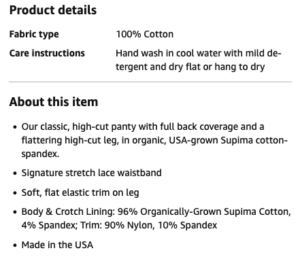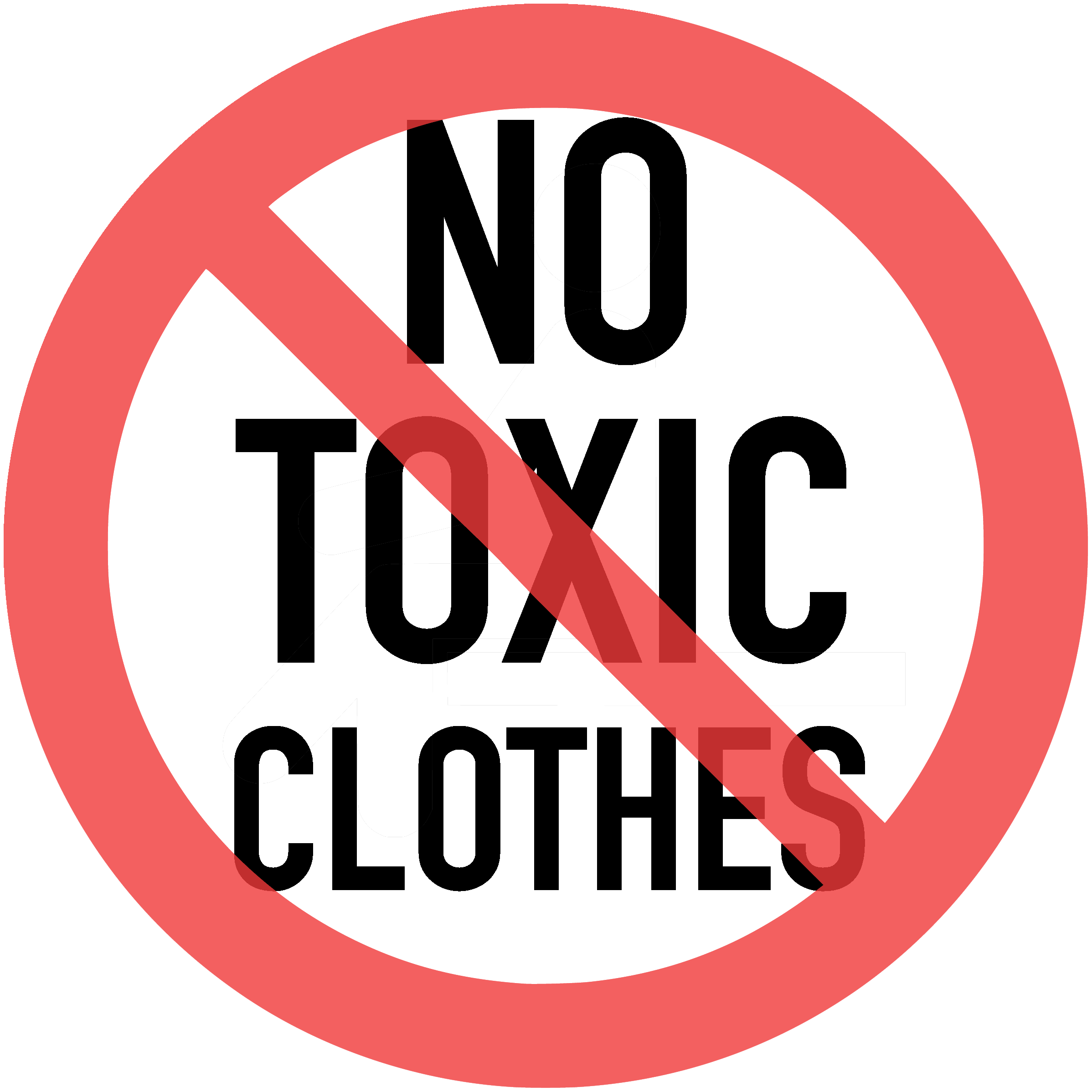At Feel Good Mercantile, we do your “pre-shopping” for you — we seek out plastic-free, sensory-friendly clothing and goods. When we find something that meets our standards, we summarize the info for you, provide helpful images, and link you to it.
We can’t guarantee that you won’t be sensitive to the clothing and other products on our site — there are so many individual factors. But with these products, you have the best chance of finding clothes that don’t aggravate your sensitivities, and that make you feel very, very good.
Is the Fabric Toxic?
That’s the first question we have to ask — and it disqualifies probably 98% of the clothing in the world. And a huge percentage of sellers bend over backwards to avoid telling you what their clothing is made of.
For example, when you search for “organic cotton” clothing, you get a lot of items that are just trying to seem good and that are actually toxic — such as organic cotton plus spandex or some other petroleum-based fiber. And sometimes there isn’t even an intent to deceive involved — it’s just a matter of the store interface not being set up to accurately and consistently display the info you need.
Here, the fabric type is listed as “100% cotton,” but it’s really organic cotton, plus lyocell, plus elastane. No filters or searches on Amazon are going to save you from this kind of confusion.

Here, a product is listed as 100% cotton, but the main garment is actually 96% organic cotton plus 4% spandex, and the trim is 90% nylon and 10% spandex.

This kind of mislabeling is the rule, not the exception.
On many products, info about the actual material(s) the item is made of is just not provided — whether through intention or incompetence. On others, you have to search through all the info on the product page and read the reviews and maybe ask some questions and wait for those replies in order to see if the product is even an option for you.
We’ve done that work for you. As Theodore Sturgeon said, “90% of everything is crap.” When it comes to clothing, the percentage that is crap — toxic! — is even higher. Maybe 1 to 2% of clothing can be considered non-toxic. It’s a reflection of our world. Once you (we) do find those non-toxic garments, though, they are often very much worth knowing about.
And, of course, many fabrics get their colors from toxic dyes. We look for certified-safe clothing and choose brands and products that show a commitment to the health of their customers and the Earth.
For a deep look at which fabrics are toxic and which are not, see our article, “What to Wear?”
Greenwashing & Confusion
A huge percentage of clothes that claim to be plastic-free contain 5 percent or more of elastane – spandex — which is petroleum-based. If manufacturers use organic cotton, they just ignore the 5% spandex and say their garments are made of “100% organic cotton.” Yes – except for the plastic, petroleum-based part of the fabric!
We understand why they add the spandex. It’s hard to sell leggings that sag. But with techniques like rib-knitting and mechanical stretch available, using toxic fabric in order to compete in the market is a short-sighted strategy. Our skin doesn’t care why they do it. Our skin hurts, touching plastic all the time. And so does theirs, actually. For most people it’s pretty much 24/7 plastic on skin. Our skin doesn’t like it. We’ll support the people offering non-toxic products, and, if your leggings or undies aren’t quite as stretchy as they used to be, at least they don’t hurt.
Our skin is a porous organ. It soaks things up. Why stew it in a vat of petroleum products? We’ve been brainwashed to accept clothes made out of poisonous chemicals — so cheap to manufacture.
Many garment manufacturers who proclaim themselves as being “sustainable” or eco-conscious use plastic and polyester in their products — but because it has been recycled, they are classified as green businesses. Yes, but… It’s good that their clothes hurt the planet less, but what about your skin? What about your health? And even recycled plastic and polyester fabrics that meet the additional certification showing they are “harmless to humans,” the fabrics still are not letting your skin breathe. They’re still wrapping you up in a plastic bag.
It’s handy for sellers to have buyers who are not conscious of the lack of quality of their products – who think that the sellers’ business as usual is the proper way of things.
Is It Comfortable?
If we can tell there’s a tag inside the garment neck, we won’t even consider it. Sometimes, though, we can’t tell from the information available, so be aware. We find that a lot of times when companies print the label inside the neck, after a few washings it’s miserably cracked and scratchy, so if a company says that they do this, we let you know.
Are there plastic strips sewn into the seams? This happens a lot with non-woven fabrics. We don’t include rayons on this site, but you might also find this despicable practice in semi-synthetics such as lyocel — if we see it, we tell you.
We look for clothing that is smart about having seams in places where they’re most comfortable for you.
Are there zippers or buttons or other hard or non-natural elements against the skin? Is movement constricted?
How We Earn
In many cases, we don’t earn anything when you buy a product. We just strive to link you to the best things, regardless of whether we profit from it.
We are an Amazon affiliate, and we earn a commission from qualifying purchases, usually around 4%. These fees are already included in the price Amazon charges for the item. You buy directly from Amazon using your Amazon account, and the shipping and return policies are Amazon’s.
It’s a pain to sort through this – but we’ve done it for you, and for ourselves. Sit back and enjoy. There are many wonderful, very appealing, sensory-friendly clothes and goods available – they’re hard to find not because they don’t exist but because the system is not set up to shut out plastic.
It’s a new focus for those in the know.
